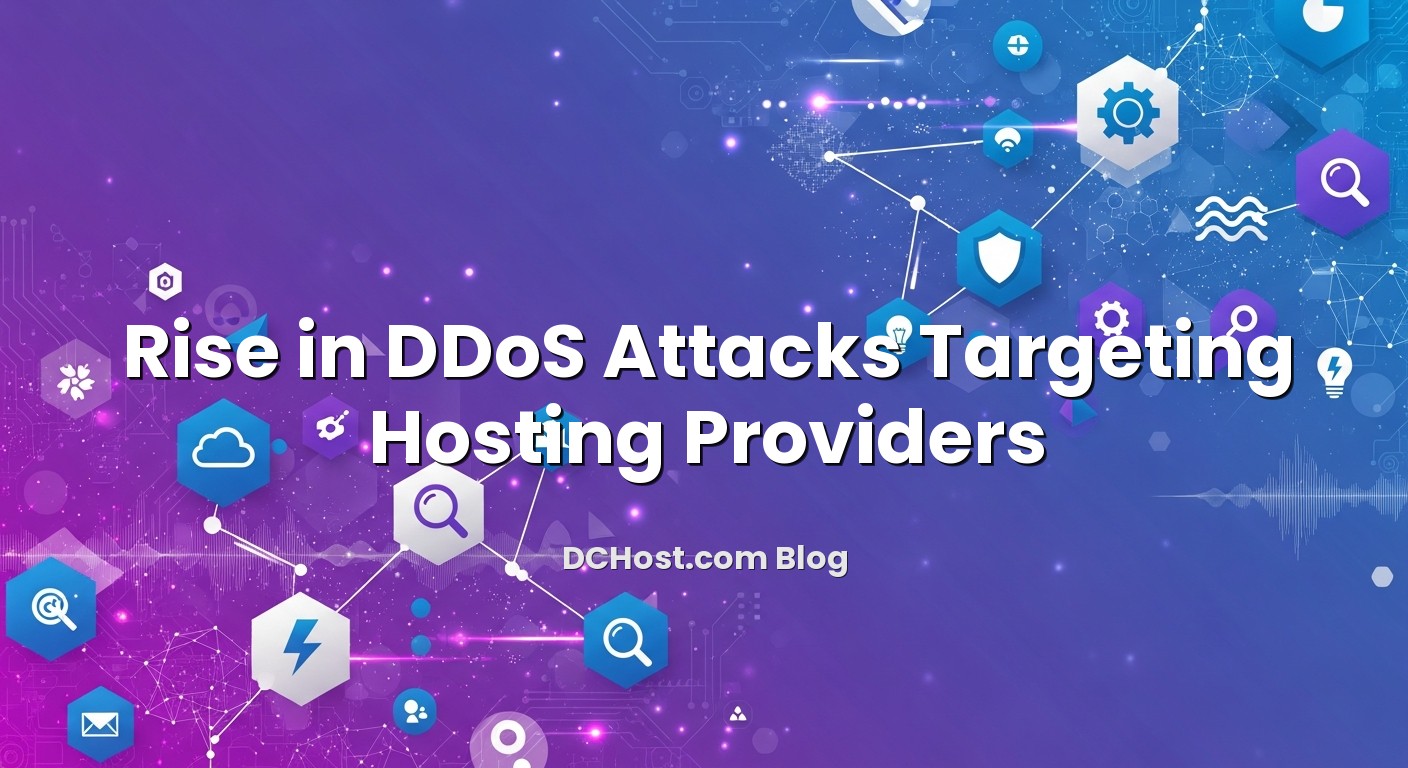DDoS attacks have been around for decades, but over the last few years we’ve seen a clear pattern: attackers are increasingly going after hosting providers themselves, not just individual websites. When a data center network, shared hosting node, VPS cluster or DNS platform is overwhelmed, hundreds or even thousands of customers feel the impact at once. If you run an online business, SaaS product, WooCommerce shop or even a busy blog, this shift matters directly to your uptime, revenue and reputation. In this article, I’ll walk through why DDoS attacks targeting hosting providers are rising, what they look like in practice, and how both your hosting partner and your own team can build realistic, layered defenses. We’ll stay focused on concrete examples and practical steps you can implement on shared hosting, VPS, dedicated servers or colocation—so you can treat DDoS as a managed risk, not a permanent source of anxiety.
İçindekiler
- 1 Why DDoS Attacks Against Hosting Providers Are Rising
- 2 How Modern DDoS Campaigns Target Hosting Infrastructure
- 3 What This Means for Your Websites and Applications
- 4 Defensive Layers Hosting Providers Need Today
- 5 What We Do at dchost.com to Mitigate DDoS Risk
- 6 Practical Steps You Can Take as a Customer
- 7 Staying Online in an Era of Constant DDoS Pressure
Why DDoS Attacks Against Hosting Providers Are Rising
Attackers Prefer Leverage Over Single Targets
From an attacker’s perspective, a hosting provider is a high‑leverage target. Disrupting one online store for an hour hurts one business. Taking down a hosting provider’s upstream network, shared platform or DNS affects hundreds or thousands of domains at once. That makes providers attractive targets for:
- Extortion campaigns (“pay or we’ll keep attacking your infrastructure”)
- Ideological or political motives (protests targeting platforms hosting certain content)
- Competitive sabotage (unethical attempts to tarnish a rival’s uptime reputation)
- Opportunistic botnet owners testing firepower on big, visible targets
This isn’t theoretical. On our side at dchost.com, we regularly see background noise from botnets probing ranges, trying small floods or protocol tricks against infrastructure, not just individual websites. Most of it is automatically mitigated, but the pattern is clear: the provider itself is now part of the threat surface.
DDoS Is Cheap, Commoditized and Easy to Rent
Another driver is how trivially easy it has become to launch an attack. In underground markets, you can buy DDoS‑for‑hire services by the hour or day, with point‑and‑click dashboards and live traffic graphs. Attackers don’t need deep networking knowledge; they just select a target IP range or hostname and choose a pre‑built attack profile.
Meanwhile, the global internet has far more bandwidth and far more insecure devices than a decade ago. Botnets build themselves from:
- Unpatched routers and IoT devices (cameras, DVRs, smart gadgets)
- Compromised servers with weak or reused credentials
- Abused open services (DNS, NTP, Memcached, CLDAP) for amplification
That combination—more bots, more bandwidth, easier tools—means even mid‑size botnet operators can push traffic volumes measured in the hundreds of Gbps or millions of packets per second. Hosting providers must assume serious firepower is available to almost anyone with a budget equivalent to a night out.
Infrastructure Is More Centralized Than We Like to Admit
Consolidation in the hosting and domain industry has created larger, more centralized platforms. Many businesses rely on:
- A single hosting provider for shared hosting, VPS and email
- One DNS platform for all their domains
- One data center region or facility for production workloads
We’ve written before about how this concentration increases the feeling that hosting is getting riskier each year. When a provider’s upstream link or core routing is saturated, there often isn’t a quick, painless failover—unless both the provider and the customer have deliberately designed for that scenario in advance.
IPv4 Scarcity and Amplification Vectors
Another subtle factor is the state of IPv4. As IPv4 addresses have become more expensive and scarce, large contiguous IPv4 ranges owned by hosting providers have turned into high‑value targets. Attackers can sweep entire ranges to discover open services that can be abused for amplification and reflection attacks, or they can try to saturate whole blocks used by shared or VPS infrastructure.
At the same time, many legacy services that are easiest to abuse for amplification still live primarily on IPv4. That means providers must maintain tighter controls and better monitoring across their IPv4 space, while also embracing IPv6 in a way that doesn’t introduce new blind spots.
How Modern DDoS Campaigns Target Hosting Infrastructure
Volumetric Network Floods (Layer 3/4)
Volumetric attacks aim to overwhelm raw bandwidth or packets‑per‑second limits. Common patterns include:
- UDP floods against random or specific ports
- SYN floods that create half‑open TCP connections
- Amplification via abused DNS, NTP, Memcached or SSDP servers
When directed at a hosting provider, these floods typically target:
- Core router IPs or upstream transit links
- Shared load balancers in front of web or mail clusters
- DNS server IPs that host zones for many domains
The goal is simple: saturate the pipes so that legitimate traffic can’t even reach the edge. No amount of clever application logic helps if packets never get that far. That’s why providers need capacity planning, scrubbing centers and network‑level controls, not just server‑side tuning.
Protocol and State‑Exhaustion Attacks
More surgical attackers focus on exhausting stateful components in the hosting stack:
- Firewall connection tables
- Load balancer session or health‑check capacity
- TCP stacks on edge proxies or reverse proxies
These attacks use traffic patterns that look “almost legitimate” from a pure bandwidth perspective but are designed to consume expensive resources like memory or CPU per connection. Examples include:
- SYN/ACK reflection that forces targets to maintain lots of pending state
- Slowloris‑style partial HTTP requests that hold connections open
- Malformed TLS handshakes that trigger expensive cryptographic operations
Here, careful tuning of kernel networking parameters and firewall rules makes a huge difference. If you’re running your own VPS or dedicated server, it’s worth reading our nftables firewall cookbook for VPS and our guide on Linux TCP tuning for high‑traffic sites—these same techniques help absorb smaller state‑exhaustion attempts before they become outages.
Layer‑7 (application‑layer) DDoS campaigns target the application stack itself: web servers, PHP, databases and caches. When they aim at a hosting provider, attackers often:
- Send high‑rate HTTP(S) GET/POST requests to many shared hosting sites simultaneously
- Focus on expensive endpoints (search, cart, login, XML‑RPC, API routes)
- Randomize URLs, user‑agents and headers to bypass naive rate limits
Even if total bandwidth isn’t huge, the cumulative effect is brutal: CPU usage spikes on shared PHP or application servers, database query rates climb, and caches are constantly invalidated. On multi‑tenant platforms, a campaign targeting just a few domains can make the whole node sluggish.
This is where web application firewalls (WAF), bot protection and smart caching become indispensable. In a previous article, we walked through how WAF and bot protection work together with ModSecurity and Fail2ban; those same ideas apply at provider scale to protect all customers behind shared infrastructure.
Multi‑Vector, Long‑Running Campaigns
The most serious DDoS incidents hosting providers see today are rarely one‑shot floods. They tend to be multi‑vector and adaptive:
- Start with a big UDP or SYN flood to test capacity and reaction time
- Shift to application‑layer attacks once basic filtering kicks in
- Change source IPs, ports and payloads as mitigations are deployed
- Pause and resume over days or weeks to apply pressure or extortion
For providers and customers alike, that means defense can’t be a single configuration tweak. It has to be a process: detection, analysis, adaptation and communication. You don’t just “flip on DDoS protection” once; you build runbooks and monitoring that let you respond intelligently as attack patterns evolve.
What This Means for Your Websites and Applications
Bigger Blast Radius Than a Single IP
When attackers aim at hosting providers, the blast radius often includes:
- Multiple websites on the same shared hosting server
- Many VPS instances on the same hypervisor or network segment
- DNS for all domains hosted on a specific name server cluster
That’s why even if your own site is quiet and well‑behaved, you might still feel slowdown or short outages when a noisy neighbor is being targeted or when the provider’s upstream is under pressure. The quality of your provider’s segmentation, rate limiting, capacity planning and incident response directly shapes your risk.
Uptime, SEO and Customer Trust
From a business perspective, sustained or repeated DDoS incidents translate into:
- Uptime drops that show up in monitors and SLA reports
- Lost orders for e‑commerce sites, especially during campaigns targeting peak hours
- SEO damage if search engines repeatedly encounter timeouts or 5xx errors
- Support load as customers open tickets and social media fills with “site down?” questions
If you want a deeper dive into the business side of uptime and what “99.9%” really means in days and minutes, we’ve covered that in our article on what uptime is and how to ensure continuous availability. DDoS risk is one of the key inputs to those uptime calculations.
The type of hosting you use changes how DDoS risk is felt:
- Shared hosting: You rely almost entirely on the provider’s defenses and resource isolation. A well‑engineered platform should prevent one attacked site from overwhelming the whole node.
- VPS: You control the OS and firewall, but the provider controls the network edge. You can mitigate smaller attacks yourself and rely on the provider for big floods.
- Dedicated servers: You have more predictable resources and can implement custom DDoS mitigations, but you still share upstream links with others.
- Colocation: You own the hardware and often more of the network stack, but you also need a provider that offers DDoS‑aware transit, scrubbing and routing options.
At dchost.com, we treat DDoS as a shared responsibility: the network, routing and shared platforms are our job; OS‑level hardening and application behavior are where we help you with guidance, templates and best practices.
Defensive Layers Hosting Providers Need Today
Network‑Level Controls and Scrubbing
At the outermost layer, hosting providers need:
- Sufficient upstream capacity and diverse transit providers
- Access to DDoS scrubbing that can filter traffic before it hits the data center
- BGP blackholing and traffic steering for sacrificial /32s when necessary
- Strict egress filtering to avoid participating in amplification attacks
These measures don’t eliminate attacks, but they prevent most volumetric floods from turning into total outages. They also let providers keep clean traffic flowing to unaffected services while one range or target is being scrubbed.
Host‑Level Firewalls and Rate Limiting
Even with solid edge defenses, individual servers (shared hosting nodes, VPS hosts, dedicated boxes) still need smart, stateful firewalls and rate limits. Techniques we regularly apply at dchost.com include:
- Connection limits per IP and per service (e.g., SSH, HTTP, SMTP)
- Synflood protection using kernel parameters and firewall rules
- Rate‑limited ICMP and UDP to reduce amplification abuse
- Automated blocking of known bad IP ranges via tools like Fail2ban
If you manage your own VPS, applying these ideas is well within reach. Our article on securing a VPS server without drama is a good companion to our nftables cookbook, and together they form a strong base against small to medium DDoS attempts.
WAF, Bot Protection and Application‑Layer Rules
Because so much of today’s DDoS activity happens at layer 7, providers also need to protect:
- Common CMS platforms (WordPress, WooCommerce, popular e‑commerce scripts)
- APIs exposed by SaaS and custom applications
- Login, search, cart and checkout endpoints
We use a combination of:
- ModSecurity with OWASP CRS tuned to reduce false positives
- Bot and rate‑limit rules based on path, user‑agent and behavioral signals
- Edge caching and CDN integration where appropriate
For a deeper look at how WAF rules, bot filters and tools like Fail2ban complement each other, see our article on layered WAF and bot protection. When those controls are applied at provider scale, your individual applications benefit even if you never touch a WAF rule directly.
DNS, Anycast and Smart TTLs
DNS is a frequent DDoS target because it’s both critical and relatively lightweight per query. Providers can improve resilience by:
- Running multiple DNS servers in diverse locations
- Using Anycast DNS so attacks are absorbed across many edges
- Encouraging customers to use reasonable TTLs for important records
We’ve covered the benefits of Anycast and automatic failover in detail in our guide on how Anycast DNS and automatic failover keep your site up. Those same patterns make DNS more resilient to DDoS, making it harder for attackers to knock out name resolution.
Monitoring, Telemetry and Runbooks
No DDoS defense works well without good visibility and procedures. On our side, that means:
- Network‑level dashboards showing traffic by protocol, source, destination and ASN
- Per‑server metrics (CPU, RAM, connections, error rates) with alerts
- Log aggregation to quickly spot patterns in HTTP, firewall and system logs
- Runbooks outlining what to do when specific thresholds or patterns are detected
If you run your own VPS or dedicated servers, the same mindset applies. Our guides on VPS monitoring and alerts with Prometheus, Grafana and Uptime Kuma and centralized logging can help you build that observability layer so you’re not flying blind during an incident.
What We Do at dchost.com to Mitigate DDoS Risk
At dchost.com, we design our hosting, VPS, dedicated server and colocation services around the assumption that DDoS attempts are a normal background condition, not a rare exception. In practice, that means:
- Working with upstream partners who provide DDoS‑aware transit and scrubbing
- Segmenting infrastructure so a single attacked IP or service doesn’t drag everything down
- Applying tuned firewall rules and kernel settings on hypervisors and shared hosting nodes
- Integrating WAF and rate‑limiting for common web workloads
For customers on VPS or dedicated servers, we provide best‑practice templates and documented settings so you can harden your own instance without starting from scratch. For colocation clients, we collaborate on routing and ACL strategies that fit your specific hardware and traffic profile.
DNS, Domains and SSL With Security in Mind
Because we also provide domain registration and DNS hosting, we pay special attention to making sure that DNS stays resolvable even under stress. Combined with proper SSL/TLS configuration and HTTP security headers, this reduces the number of attack surfaces that can be exploited or amplified.
If you’re interested in strengthening that part of your stack, we’ve written friendly guides on understanding DNS records and on setting up HTTP security headers. Solid basics here make certain kinds of abuse and misconfiguration‑driven outages much less likely.
Calm Incident Response and Transparent Communication
When a significant DDoS incident does occur, the difference between “frustrating disruption” and “business‑critical disaster” is often how quickly and calmly everyone responds. Our internal runbooks include:
- Clear escalation paths from NOC to network engineering to platform teams
- Pre‑approved mitigation steps for different attack types and severities
- Criteria for when to reroute, blackhole or sacrificially isolate targets
- Customer communication templates that explain what’s happening in plain language
The goal isn’t to pretend we can magically make all DDoS risk disappear. It’s to make sure that when something serious happens, you see a coherent, predictable response rather than chaos.
Practical Steps You Can Take as a Customer
Harden Your Own Services
Even on well‑protected infrastructure, you can significantly improve your resilience by:
- Rate‑limiting login, search and API endpoints at the web server or application layer
- Using a WAF (at the provider, CDN or application level) to block obvious abuse
- Enabling and tuning caching (page caching for WordPress, object caches like Redis, HTTP caching headers)
- Disabling or protecting unused or risky features (e.g., WordPress XML‑RPC if you don’t need it)
We have several hands‑on guides that walk through these improvements for common stacks like WordPress and WooCommerce. They’re primarily written from a performance and security standpoint, but they naturally increase your resistance to DDoS‑like traffic patterns too.
Design for Graceful Degradation
Not every spike in traffic is an attack, and not every attack must result in a complete outage. Aim for graceful degradation under stress:
- Serve cached content where possible, even if parts of the site are temporarily limited
- Show simple, fast error or queue pages instead of timing out
- Disable non‑essential features (search, recommendations, heavy widgets) during incidents
- Keep an eye on database load and be ready to temporarily reduce costly reports or background jobs
These are architectural choices rather than last‑minute tweaks. If you’re planning a new project or re‑platforming, it’s worth adding DDoS and failure‑mode discussions into the design phase alongside performance and SEO.
Use DNS and TTLs Strategically
Many organizations discover during an incident that their DNS configuration makes rapid changes difficult. Spend a bit of time upfront to:
- Set reasonable TTLs (not too high, not too low) for key records like
A,AAAAandMX - Avoid overly complex CNAME chains that can fail in surprising ways
- Document which records would need to change in a DDoS or outage scenario
Our guide on TTL strategies for zero‑downtime migrations is written with migrations in mind, but the same logic applies to routing around DDoS‑induced issues when you have alternative endpoints or backup infrastructure available.
Have a Simple, Written Plan
You don’t need a 50‑page disaster recovery manual, but you do need something more than “we’ll figure it out on the day”. At minimum:
- List your most critical domains, services and endpoints
- Write down who can make DNS changes and how
- Note how to contact your hosting provider’s support and what information they’ll need
- Decide in advance how you’ll communicate with your own customers or users
If you’d like to go deeper, our article on writing a no‑drama disaster recovery plan covers how to turn that basic list into a practical runbook without getting lost in theory.
Staying Online in an Era of Constant DDoS Pressure
DDoS attacks targeting hosting providers are not going away; if anything, they’re becoming a routine part of the background noise of the internet. The good news is that both providers and customers have far better tools, patterns and experience than a decade ago. With layered defenses at the network, host, application and DNS levels—and with monitoring and runbooks that let us respond calmly—DDoS becomes a manageable risk rather than an existential threat.
At dchost.com, we see our role as giving you a solid, DDoS‑aware foundation for your domains, hosting, VPS, dedicated servers and colocation, plus the practical guidance you need to harden your own applications. If you’re planning a new project, facing rapid traffic growth or simply want to review how resilient your current setup is, reach out to our team. We’re happy to help you map your current risk, choose the right service layer and implement the sensible, real‑world protections that keep your sites and apps available—even when the wider internet gets noisy.





